Power–Pitch Cascade Control-Based Approach for the Up/Down-Regulated Operation of Large Wind Turbines
Abstract
1. Introduction
2. The Down-Regulation Control Problem
- (1)
- If the wind turbine is operated in Region III, the wind speed is always sufficient to carry out the down-regulation, but the up-regulation is limited to the maximum current wind speed;
- (2)
- If the wind turbine is working in Region II, the down-regulation requires that the given power reference Pref is lower than the maximum extractable power Pmax(vw) for the current wind speed vw. Up-regulation is not possible because the wind speed is not enough to scale up the power;
- (3)
- If the power reference Pref is greater than the maximum extractable power Pmax(vw), the down-regulation is not available, but the power output should be as close as the current wind speed makes it possible to the power reference Pref. As in condition 2, up-regulation is also not possible;
- (4)
- The power network is kept as constant and stable as possible. Hence, the power reference for the wind turbine does not change often, and it is provided by the wind farm control through the local supervisory control.
3. Description of the New Control Approach
3.1. Torque Control Approach
3.2. Pitch Control Approach
3.3. Combined Torque/Pitch Control Approach
3.4. Problem of Power Reference Greater than the Maximum Extractable Power
3.5. Adaptive Control Using a Gain Scheduling Approach
4. Numerical Study
4.1. Description of the Reference Wind Turbine
4.2. Simulation Setup
4.3. Controller Design
5. Results and Analysis
6. Conclusions
Funding
Data Availability Statement
Acknowledgments
Conflicts of Interest
Abbreviations
| BMWK | Federal Ministry of Economic Affairs and Climate Action (in German) |
| CPC | Collective Pitch Control |
| DRC | Down-Regulation Control |
| MKS | Meter Kilogram Second |
| MPPT | Maximum Power Point Tracking |
| NPI | Nonlinear Proportional Integral |
| OTC | Optimal Torque Control |
| PI | Proportional Integral |
| PSFC | Power Signal Feedback Control |
| Nomenclature | |
| Parameters | |
| β0 | Pitch angle at the operating point, rad |
| Cp | Power coefficient, — |
| Cp,max | Maximum value of the power coefficient, — |
| Kp, Ki | Gains of PI controller |
| Kp1, Kp2, Kp3, Ki1, Ki2, Ki3 | Gains of NPI controller |
| nx | Gearbox ratio, — |
| Prated | Rated power, MW |
| R | Rotor radius, m |
| Tg,rated | Rated generator torque, kg m2 |
| vci | Cut-in value for the wind speed, m/s |
| vco | Cut-out value for the wind speed, m/s |
| vv,rated | Rated value for the wind speed, m/s |
| λ | Tip-speed ratio |
| λ* | Optimal tip-speed ratio |
| η | Efficiency |
| ρa | Density of air, kg/m3 |
| ωg,rated | Rated value of the generator speed, rad/s |
| ωgsp | Set point for the generator speed, rad/s |
| Variables | |
| β | Pitch angle, rad |
| βa | Output of pitch actuators, rad |
| e | Control error |
| λ | Tip-speed ratio, — |
| P | Power, MW |
| Pref | Power reference, MW |
| t | Time |
| Tga | Output of the torque controller, kg m2 |
| Tg | Generator torque (on the low-speed shaft), kg m2 |
| vv | Wind speed, m/s |
| ωg | Generator speed, rad/s |
| ωg* | Set point for the torque controller, rad/s |
| xi | State variable of integrator |
References
- Mirzaei, M.; Soltani, M.; Poulsen, N.K.; Niemann, H.H. Model based active power control of a wind turbine. In Proceedings of the 2014 American Control Conference, Portland, OR, USA, 4–6 July 2014; pp. 5037–5042. [Google Scholar] [CrossRef]
- Aho, J.; Buckspan, A.; Laks, J.; Dunne, F.; Pao, L.; Fleming, P.; Churchfield, M.; Jeong, Y.; Johnson, K. A tutorial of wind turbine control for supporting grid frequency through active power control. In Proceedings of the 2012 American Control Conference (ACC), Montreal, QC, Canada, 27–29 June 2012; pp. 3120–3131. [Google Scholar] [CrossRef]
- Miller, N.W.; Clark, K. Advanced controls enable wind plants to provide ancillary services. In Proceedings of the IEEE PES General Meeting, Minneapolis, MN, USA, 25–29 July 2010; pp. 1–6. [Google Scholar] [CrossRef]
- Rivarola, A.; Gambier, A. Control of large wind energy systems for acoustic noise reduction by using multi-objective optimal control. IFAC-Pap. 2023, 56, 11255–11260. [Google Scholar] [CrossRef]
- Soini, V. Wind power intermittency and the balancing power market: Evidence from Denmark. Energy Econ. 2021, 100, 105381. [Google Scholar] [CrossRef]
- Rebello, E.; Watson, D.; Rodgers, M. Developing, implementing and testing up and down regulation to provide AGC from a 10 MW wind farm during varying wind conditions. IOP J. Phys. Conf. Ser. 2018, 1102, 012032. [Google Scholar] [CrossRef]
- Zalkind, D.S.; Nicotra, M.M.; Pao, L.Y. Constrained power reference control for wind turbines. Wind Energy 2022, 25, 914–934. [Google Scholar] [CrossRef]
- Zhu, J.; Ma, K.; Soltani, M.; Hajizadeh, A.; Chen, Z. Comparison of loads for wind turbine down-regulation strategies. In Proceedings of the 11th Asian Control Conference (ASCC), Gold Coast, QLD, Australia, 17–20 December 2017; pp. 2784–2789. [Google Scholar] [CrossRef]
- van der Hoek, D.; Kanev, S.; Engels, W. Comparison of down-regulation strategies for wind farm control and their effects on fatigue loads. In Proceedings of the 2018 Annual American Control Conference (ACC), Milwaukee, WI, USA, 27–29 June 2018; pp. 3116–3121. [Google Scholar] [CrossRef]
- Aho, J.; Pao, L.; Fleming, P. An active power control system for wind turbines capable of primary and secondary frequency control for supporting grid reliability. In Proceedings of the 51st AIAA Aerospace Sciences Meeting including the New Horizons Forum and Aerospace Exposition 2013, Grapevine, TX, USA, 7–10 January 2013; pp. 1–13. [Google Scholar] [CrossRef]
- Ma, H.; Chowdhury, B. Working towards frequency regulation with wind plants: Combined control approaches. IET Renew. Power Gener. 2010, 4, 308–316. [Google Scholar] [CrossRef]
- Elorza, I.; Calleja, C.; Pujana-Arrese, A. On wind turbine power delta control. Energies 2019, 12, 2344. [Google Scholar] [CrossRef]
- Ma, K.; Zhu, J.; Soltani, M.; Hajizadeh, A.; Chen, Z. Wind turbine down-regulation strategy for minimum wake deficit. In Proceedings of the 11th Asian Control Conference, Gold Coast, QLD, Australia, 17–20 December 2017; pp. 2652–2656. [Google Scholar] [CrossRef][Green Version]
- Juankorena, X.; Esandi, I.; Lopez, J.; Marroyo, L. Method to enable variable speed wind turbine primary regulation. In Proceedings of the International Conference on Power Engineering, Energy and Electrical Drives, Lisbon, Portugal, 18–20 March 2009; pp. 495–500. [Google Scholar]
- Antrain Juangarcia, D.; Eguinoa, I.; Knudsen, T. Derating a single wind farm turbine for reducing its wake and fatigue. J. Phys. Conf. Ser. 2018, 1037, 032039. [Google Scholar] [CrossRef]
- Lio, W.H.; Mirzaei, M.; Larsen, G.C. On wind turbine down-regulation control strategies and rotor speed set-point. J. Phys. Conf. Ser. 2018, 1037, 032040. [Google Scholar] [CrossRef]
- Gambier, A. Pitch control of three bladed large wind energy converters—A Review. Energies 2021, 14, 8083. [Google Scholar] [CrossRef]
- Bianchi, F.D.; de Battista, H.; Mantz, R.J. Wind Turbine Control Systems; Springer Nature: London, UK, 2007. [Google Scholar]
- Burton, T.; Jenkins, N.; Sharpe, D.; Bossanyi, E. Wind Energy Handbook, 2nd ed.; John Wiley & Sons: Chichester, UK, 2011. [Google Scholar]
- Gambier, A. Control of Large Wind Energy Systems; Springer Nature: Basel, Switzerland, 2022. [Google Scholar]
- Manwell, J.F.; McGowan, J.G.; Rogers, A.L. Wind Energy Explained. Theory, Design and Applications; John Wiley & Sons Ltd.: Chichester, UK, 2009. [Google Scholar]
- Meng, F.; Wai, A.; Lio, H.; Liew, J. The effect of minimum thrust coefficient control strategy on power output and loads of a wind farm. J. Phys. Conf. Ser. 2020, 1452, 012009. [Google Scholar] [CrossRef]
- Abdullah, M.A.; Yatim, A.H.M.; Tan, C.W.; Saidur, R. A review of maximum power point tracking algorithms for wind energy systems. Renew. Sustain. Energy Rev. 2012, 16, 3220–3227. [Google Scholar] [CrossRef]
- Kumar, D.; Chatterjee, K. A review of conventional and advanced MPPT algorithms for wind energy systems. Renew. Sustain. Energy Rev. 2016, 55, 957–970. [Google Scholar] [CrossRef]
- Visioli, A. Practical PID Control; Springer: London, UK, 2006. [Google Scholar]
- Wang, L. PID Control System Design and Automatic Tuning Using MATLAB/Simulink; JohnWiley & Sons Ltd.: Chichester, UK, 2020. [Google Scholar]
- Åström, K.J.; Hagglund, T. Advanced PID Control; ISA—The Instrumentation, Systems, and Automation Society: Research Triangle Park, NC, USA, 2005. [Google Scholar]
- Gambier, A.; Nazaruddin, Y. Nonlinear PID control for pitch systems of large wind energy converters. In Proceedings of the 2018 IEEE Conference on Control Technology and Applications, Copenhagen, Denmark, 21–24 August 2018; pp. 996–1001. [Google Scholar]
- Isayed, B.M.; Hawwa, M.A. A nonlinear PID control scheme for hard disk drive servosystems. In Proceedings of the 15th Mediterranean Conference on Control and Automation, Athens, Greece, 27–29 June 2007; pp. 1–6. [Google Scholar]
- Ashuri, T.; Martins JRR, A.; Zaaijer, M.B.; van Kuik, G.A.M.; van Bussel, G.J.W. Aeroservoelastic design definition of a 20 MW common research wind turbine model. Wind Energy 2016, 19, 2071–2087. [Google Scholar] [CrossRef]
- Chamoli, S.; Gambier, A. Modelling, parametrization and observer design of a 20 MW reference wind turbine for control purposes. J. Phys. Conf. Ser. 2020, 1618, 022031. [Google Scholar] [CrossRef]
- Jonkman, J.; Jonkman, B. FAST modularization framework for wind turbine simulation: Full-system linearization. J. Phys. Conf. Ser. 2016, 753, 082010. [Google Scholar] [CrossRef]
- Gambier, A. Multiobjective optimal control of wind turbines: A survey on methods and recommendations for the implementation. Energies 2022, 15, 567. [Google Scholar] [CrossRef]
- Gambier, A.; Jipp, M. Multi-objective optimal control: An introduction. In Proceedings of the Asian Control Conference, Kaohsiung, Taiwan, 15–18 May 2011; pp. 1084–1089. [Google Scholar]
- Ogata, K. Modern Control Engineering, 5th ed.; Prentice Hall: Boston, MA, USA, 2009. [Google Scholar]
- Golnaraghi, F.; Kuo, B. Automatic Control Systems; McGraw-Hill Education: New York, NY, USA, 2017. [Google Scholar]

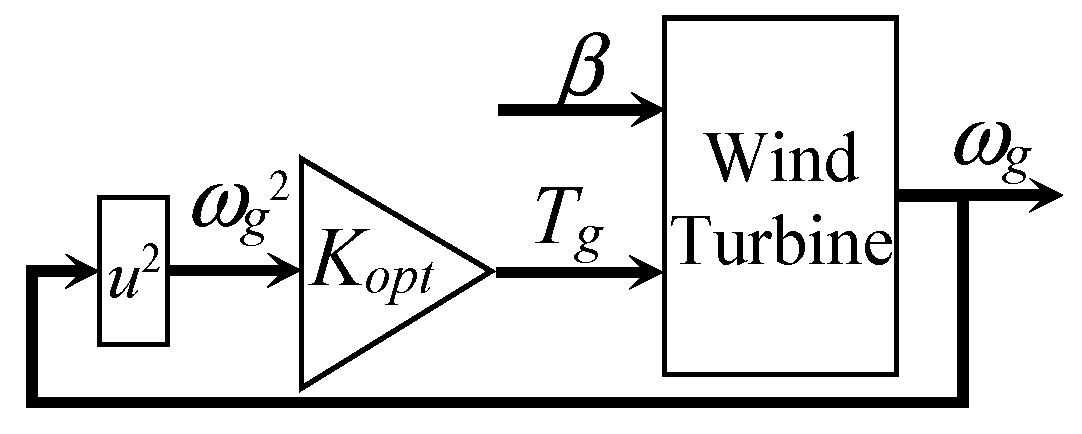



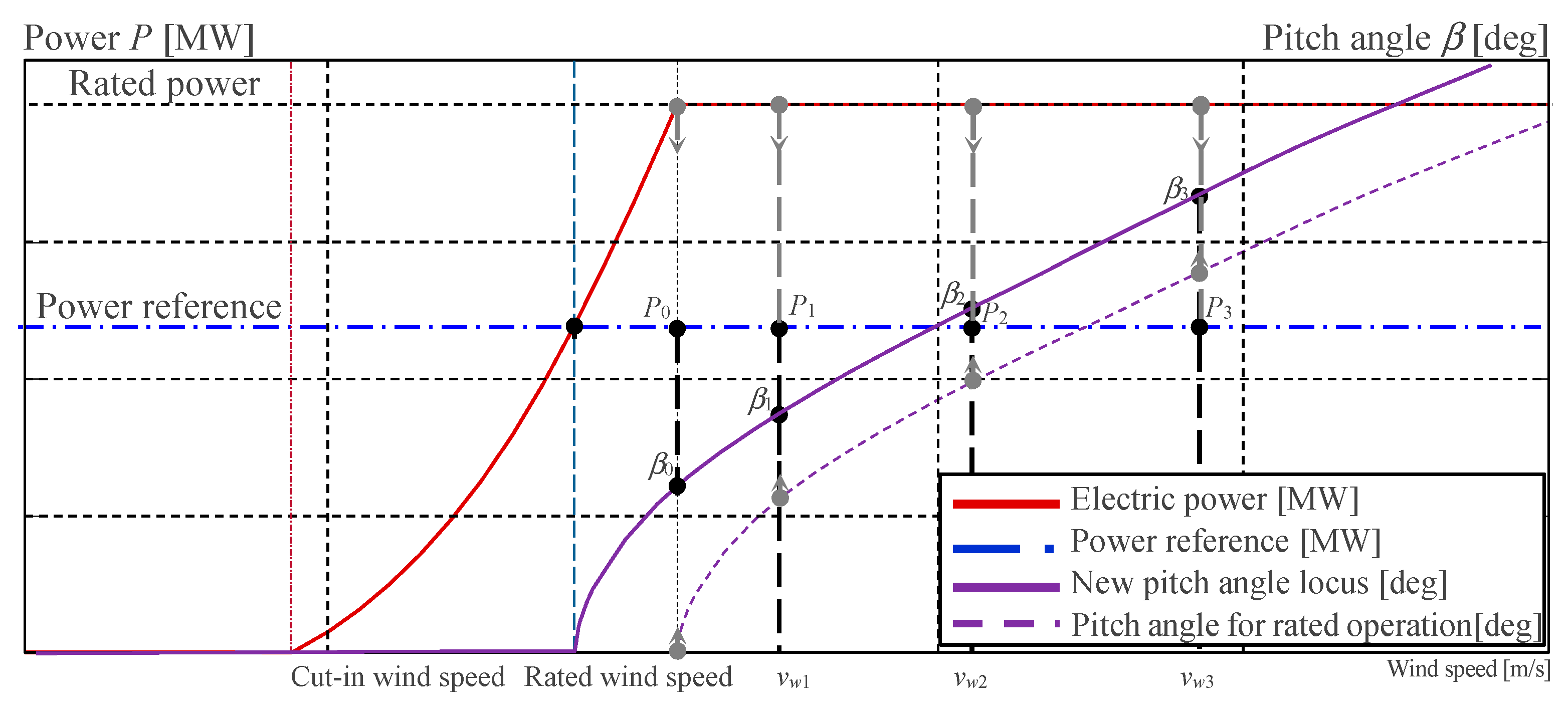

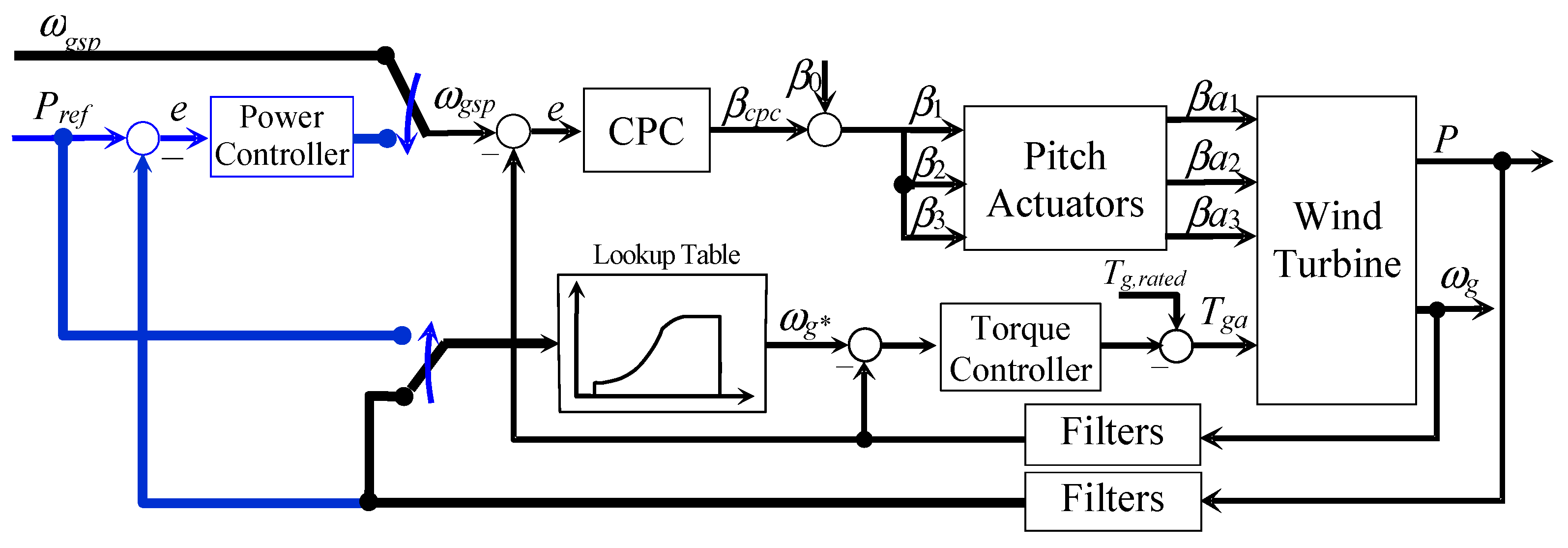


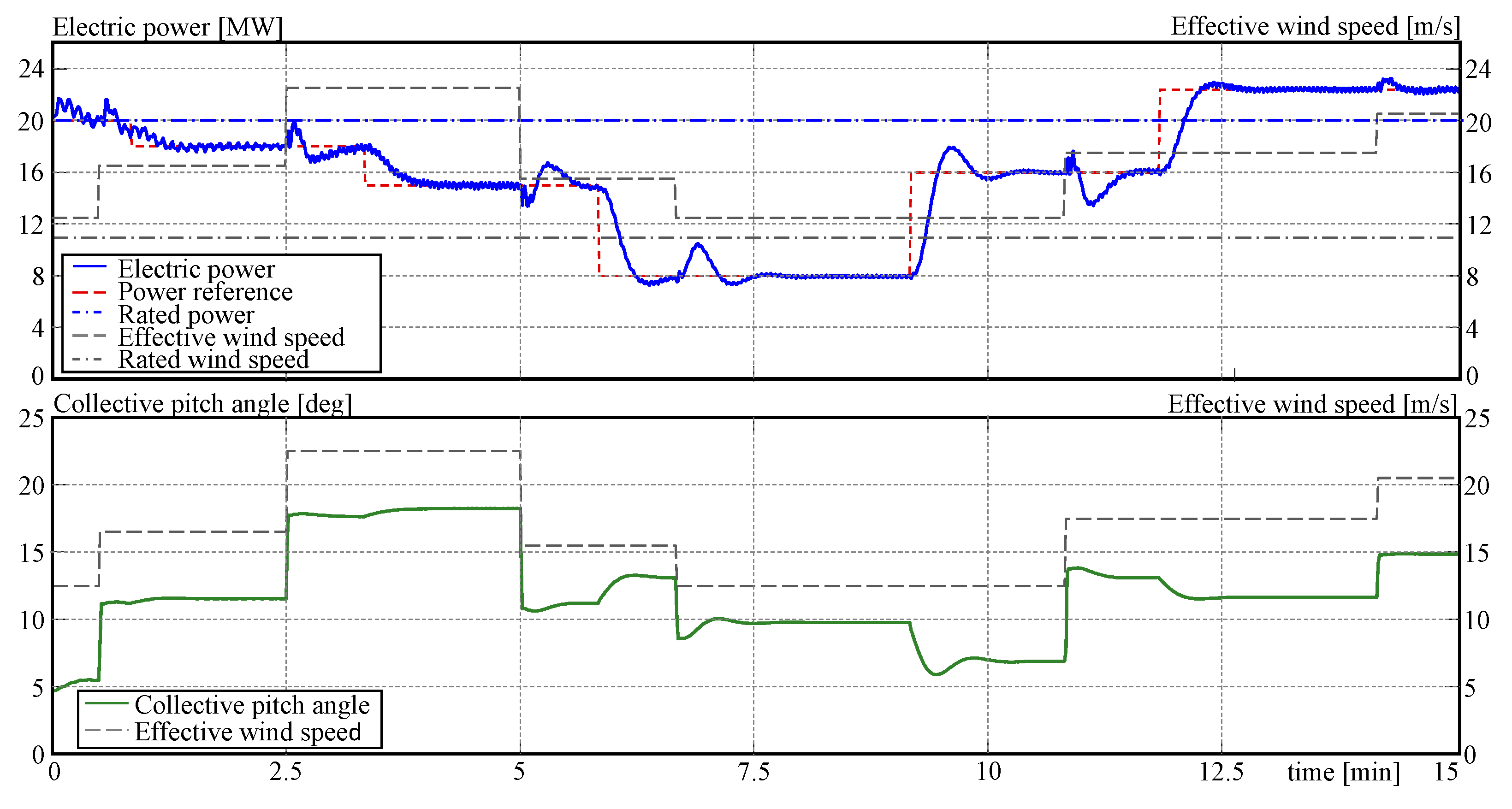
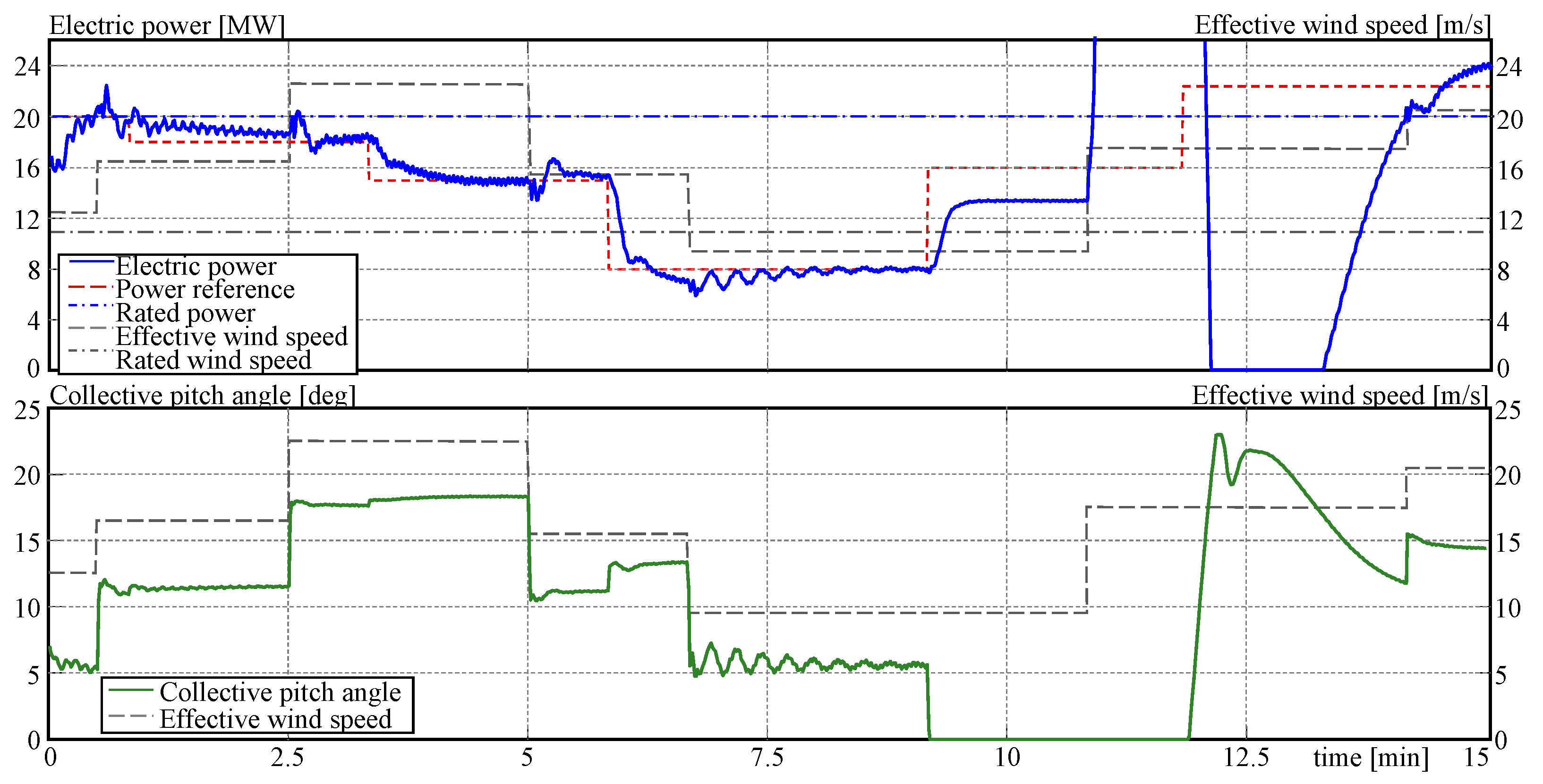
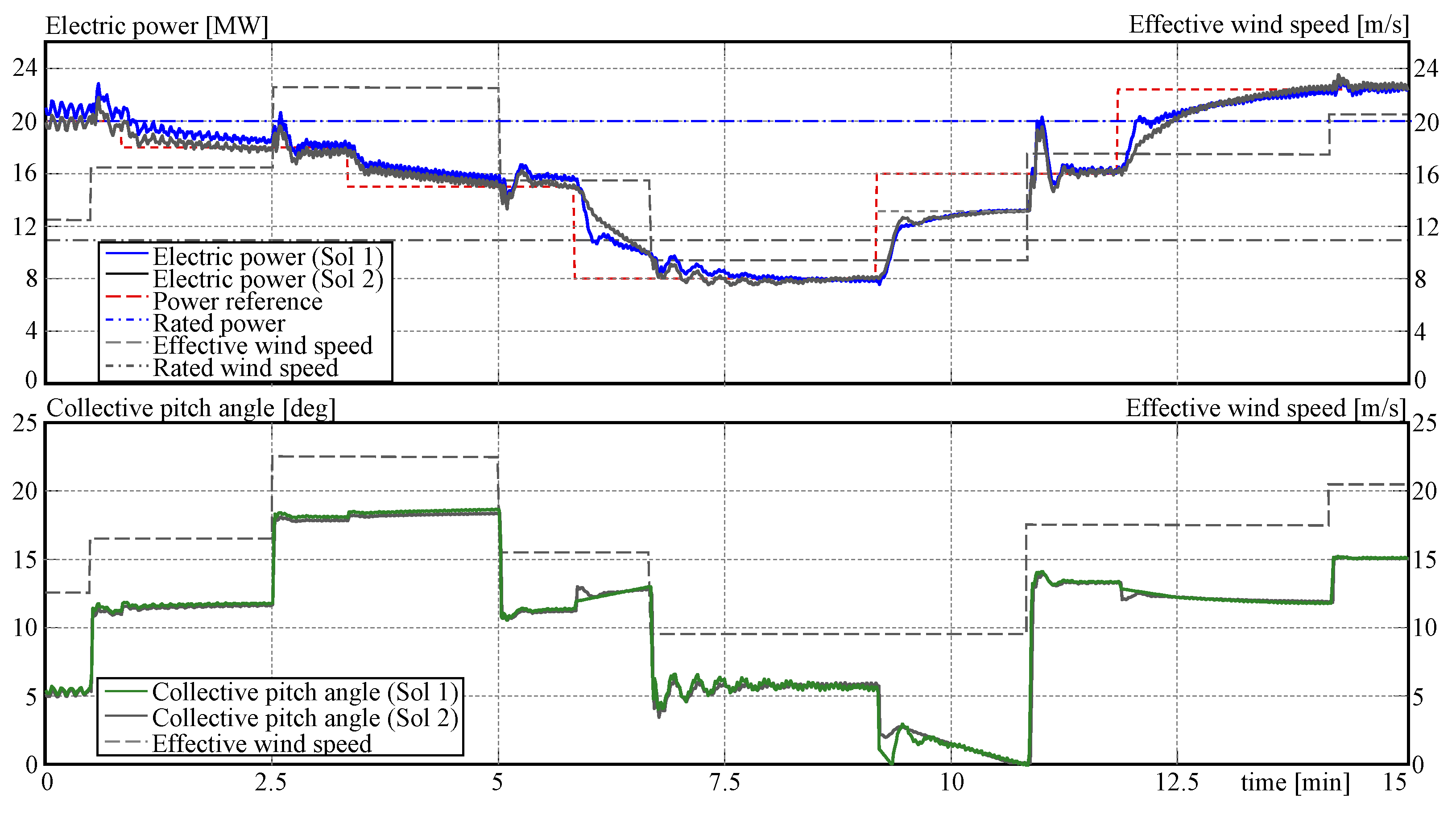
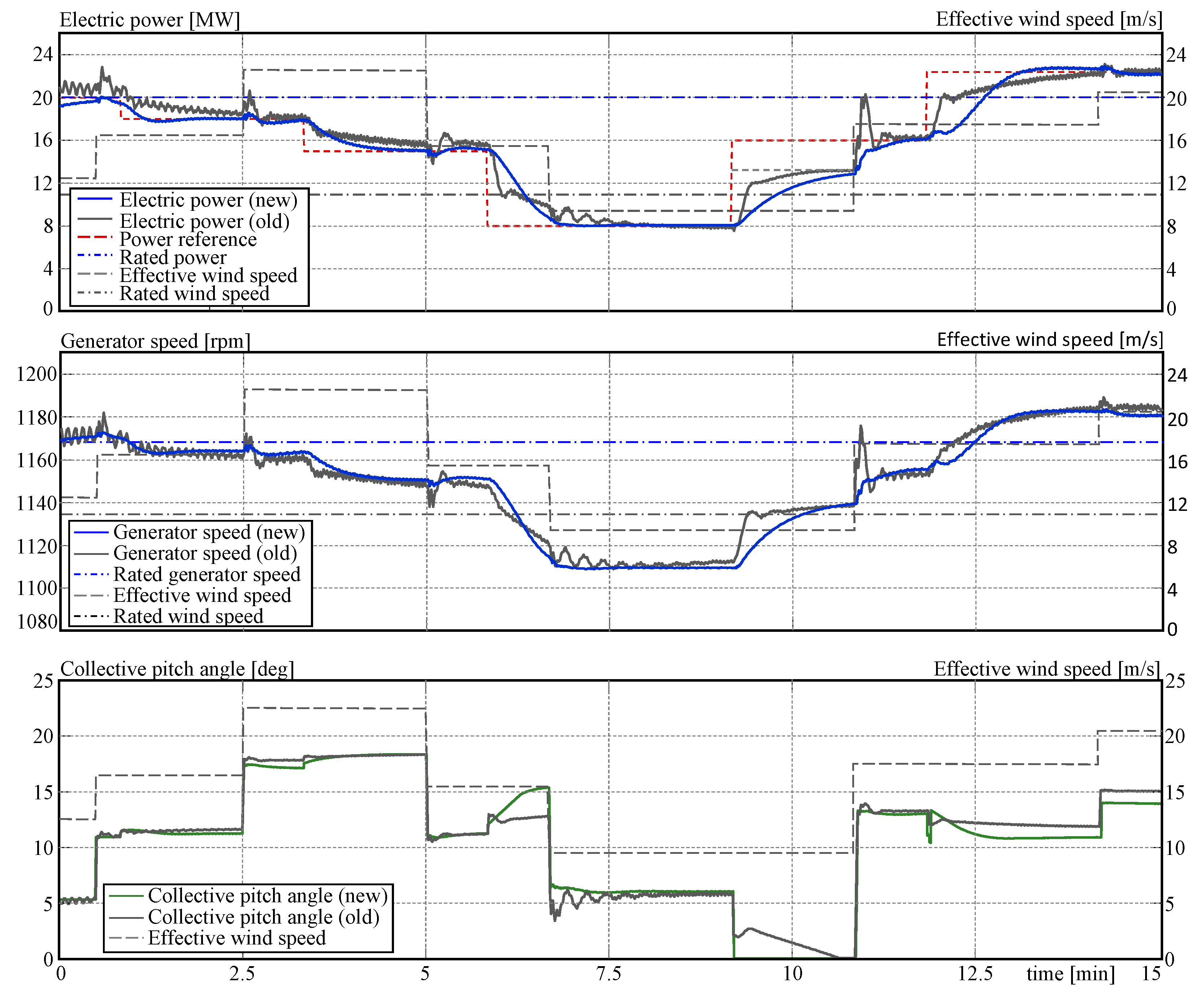
| Scenario | Wind Profile | Description |
|---|---|---|
| Scenario 1 | Region III | Tracking power control on Region III. |
| Scenario 2 | Region II & III | Tracking power control with Pref < Pmax. No gain scheduling. |
| Scenario 3 | Region II & III | Tracking power control with Pref > Pmax and integrator reset. No gain scheduling. |
| Scenario 4 | Region II & III | Tracking power control with Pref > Pmax and power reference change. No gain scheduling. |
| Scenario 5 | Region II & III | Tracking power control with Pref > Pmax, power reference change, and gain scheduling. |
| Parameters | Torque Controller | Pitch Controller | Power Controller * |
|---|---|---|---|
| Control law | PI control | PI control | Nonlinear PI control |
| Proportional gain Kp1 | 8164.50 | −0.1275 | 7,551,108.51 |
| Proportional gain Kp2 | 0 | 0 | −5,121,574.18 |
| Proportional gain Kp3 | 0 | 0 | 5.0 |
| Integral gain Ki1 | 0.012 | −0.01565 | 1825.18 |
| Integral gain Ki2 | 0 | 0 | 786.39 |
| Integral gain Ki3 | 0 | 0 | 0.0005 |
| Power Reference Value | Kp1 | Kp2 | Kp3 | Kp4 |
|---|---|---|---|---|
| 2.5 MW | 4,917,724.78 | −961,828.98 | 28,624.90 | −30,439.48 |
| 5.0 MW | 4,303,206.38 | −1,091,072.92 | 29,850.07 | −32,261.70 |
| 7.5 MW | 4,204,105.14 | −1,112,899.75 | 29,149.42 | −37,485.53 |
| 10.0 MW | 4,159,777.78 | −1,124,248.68 | 28,372.58 | −39,348.81 |
| 12.5 MW | 4,637,930.70 | −1,140,480.25 | 23,531.99 | −45,349.06 |
| 15.0 MW | 5,003,476.51 | −1,010,485.75 | 14,857.08 | −49,130.02 |
| 17.5 MW | 5,716,598.38 | 1,029,539.49 | 8457.86 | −57,567.16 |
| 20.0 MW | 7,551,108.51 | −5,121,574.18 | 1825.18 | 786.39 |
| 22.5 MW | 1,747,656.93 | −17,611.36 | 4079.56 | −5664.53 |
| 25.0 MW | 1,650,520.30 | −131,675.54 | 16,452.65 | −18,028.40 |
Disclaimer/Publisher’s Note: The statements, opinions and data contained in all publications are solely those of the individual author(s) and contributor(s) and not of MDPI and/or the editor(s). MDPI and/or the editor(s) disclaim responsibility for any injury to people or property resulting from any ideas, methods, instructions or products referred to in the content. |
© 2024 by the author. Licensee MDPI, Basel, Switzerland. This article is an open access article distributed under the terms and conditions of the Creative Commons Attribution (CC BY) license (https://creativecommons.org/licenses/by/4.0/).
Share and Cite
Gambier, A. Power–Pitch Cascade Control-Based Approach for the Up/Down-Regulated Operation of Large Wind Turbines. Appl. Sci. 2024, 14, 3396. https://doi.org/10.3390/app14083396
Gambier A. Power–Pitch Cascade Control-Based Approach for the Up/Down-Regulated Operation of Large Wind Turbines. Applied Sciences. 2024; 14(8):3396. https://doi.org/10.3390/app14083396
Chicago/Turabian StyleGambier, Adrian. 2024. "Power–Pitch Cascade Control-Based Approach for the Up/Down-Regulated Operation of Large Wind Turbines" Applied Sciences 14, no. 8: 3396. https://doi.org/10.3390/app14083396
APA StyleGambier, A. (2024). Power–Pitch Cascade Control-Based Approach for the Up/Down-Regulated Operation of Large Wind Turbines. Applied Sciences, 14(8), 3396. https://doi.org/10.3390/app14083396





